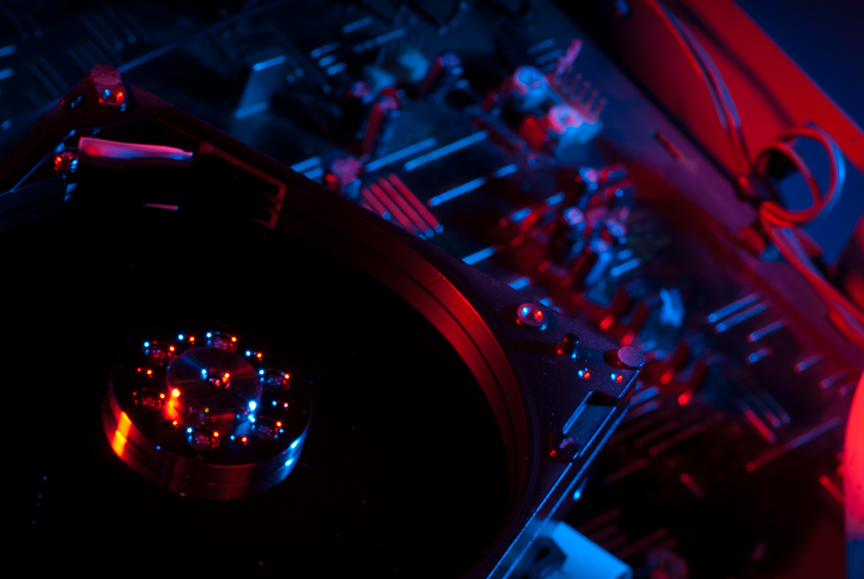There is a lot of confusion over buying the best drives for those that are not familiar with what they are and how they work. People will say things like, “The computer says I’m out of memory, so I bought a drive.”; but often memory is referring to RAM and not storage at all. They’ll ask, “Should I buy a SATA drive or a should I do RAID?”, or if they should buy “SATA or SSD”; but many SSD use SATA as well. One is a connector type and the other describes one of several storage methods. This article will hopefully cut through some of the confusion to help consumers make the best hardware choices when upgrading a PC or buying parts.
Differentiating Memory from Storage
There are different types of memory and storage in a computer. The drive contains all the things that are stored away to be loaded into active memory later. The things stored to be used immediately are stored mostly in RAM. There is even a small area called caching used to run and manage application data. A drive is used predominantly for long term storage, everything else generally requires RAM. This can all be confusing, so drive messages about space are usually referred to as “storage” or “capacity”, while “memory” is used to describe temporary storage.
The best indication of drive space issues can be found by checking the drive properties. The method to do this varies by operating system, but almost every system has a method of showing space used and what’s free in a pie chart making it easy to see. It’s generally important to have a little bit of extra space, about 12% to run normally. Any less, the system will begin giving errors about application and system problems, indicating a new drive is needed.
Types of Hard Drives
Compact Flash, SSD, and HDD are three common types of drives, but there are many other standards. Compact Flash and SSD generally run only on chips which run faster because of massive caching built into the system (Think of a small computer built into the drive). They are optimized to access data quickly and have a resistance to heat that lets them process more data faster. Compact Flash was an older, smaller, durable technology which was quite expensive, slower, and had limited size. SSD are newer, larger, and generally could be hold a lot more data.
HHD are older technology, but can also run quite fast. However, they’ll have degraded performance over time. This is why programs like Windows include utilities to defragment the drive. They rewrite the data in sequence so it can load fast again. An HHD writes data to metal platters that spin. Because the drive is mechanical and data reads from the platters as they move like a record, sequential data can be read much faster and easier than on an SSD; that said speeds are generally slightly slower than SSD overall because manufacturers do not build the massive cache that SSD require and because as non-sequential data or data that can’t be read in a single pass increases their performance drops quickly.
SATA, IDE, USB, SCSI, and EIDE
Computers have gone through a lot of connection types. Generally, cables have gotten smaller, with more pins or copper wires inside them to make them both faster and easier to manage. However, this also makes the connectors increasingly fragile. Newer connectors therefore were designed with locking mechanisms built into the ends and rectangular shields that reinforced the conductive part of the cables and made the user plug and unplug these pins safely.
With better design the cables also didn’t have to be built as solid and they became much thinner. Older standards like SCSI, IDE, and EIDE had large cables and wide connectors which could be pulled unevenly from the board and generally blocked good air-flow in the case, making the computer hotter. Think cables also have more resistance and therefore produce more heat. This limited how fast the computer could run.
Since these represent connector types, generally a drive with one type could still be used as another type with an adapter. SATA was generally better suited and faster for the inside of a computer than other standards while USB was slightly slower, but safer and easier to swap out when the computer was running. This made it ideal for external devices. While many people bought adapters at first, other standards have been going away and most consumer machines use one of these two connector types by default.
Understanding Your Hard Drive
In some devices like Android tablets, phones, and others that don’t have a hard drive the distinction on what to isn’t as important. Part of all this confusion may be that re-sellers like to use these terms to explain why people should upgrade to a new machine or a more expensive device. But generally, just like people, computers have different types of data storage and methods of accessing that data that work together to determine “how good a memory” they have. There are always a lot of different methods to gain speed and performance just like people have methods to help them remember and process information. A number just read from a phone book is not recalled the same way as someone’s first time driving. So sometimes people legitimately get the terms confused. That’s why consumers need to be informed.

